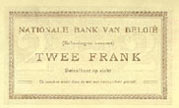
PREV ARTICLE
FULL ISSUE
PREV FULL ISSUE
FEATURED WEB PAGE: WWI EMERGENCY MONEYThis week's Featured Web page is on emergency money of World War I, from the National Bank of Belgium web site.
Everybody knows probably the stories about butter and eggs which have been smuggled from the countryside to the city during the war. But how were these butter and eggs paid for? At the outbreak of the First World War the old bills from the National Bank maintained in circulation. From 1912 onwards the National Bank started to take measures in consideration of a growing armed conflict. Five franc bills were prepared to be put into circulation in case a war should break out. The threatening international conflict spread panic among the population. People no longer trusted banknotes and at the end of July and the beginning of August 1914 they hurried to the National Bank in order to exchange their bills for coins. On top of this, a problem arose in the small money transfer. The five franc coin and the small silver coins were hoarded for their metal value and gradually disappeared from circulation. To solve this problem the National Bank brought out bills at the value of 1 and 2 francs of the current-account type. However, this would not end the problem of the scarcity of money.

www.nbbmuseum.be/2007/02/emergency-money.htmWayne Homren, Editor The Numismatic Bibliomania Society is a non-profit organization promoting numismatic literature. See our web site at coinbooks.org. To submit items for publication in The E-Sylum, write to the Editor at this address: whomren@gmail.com To subscribe go to: https://my.binhost.com/lists/listinfo/esylum All Rights Reserved. NBS Home Page Contact the NBS webmaster 
|